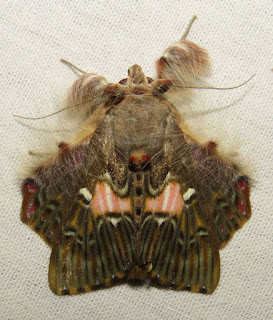August 22,
2015
We started
this morning with a relaxed vigil on the floating deck to see what early
morning bird activity we might have missed by leaving early each morning.
This pair of
Gray-breasted Martins appeared to be hoping to nest in the deck structure – or
perhaps in one of the parasols.
Other birds
we had been missing but saw this morning were Cinnamon Attila, Glossy
Antshrike, Amazonian Streaked-Antwren, and this Rufous-tailed Jacamar right by
the steps.
We then
boated upriver slowly, stopping for several birds as well as for this roost of Rhynchonycteris naso, Proboscis Bats.
We had seen
several Physocalymma scaberrimum
trees (in the family Lythraceae and closely related to crape myrtle) at Chapada
dos Guimarães, so it was interesting to see one above the banks of the river
only on the slopes of one of the major granite hills. With their lack of
water-retaining soils, these granite hills (serras)
harbor many species from farther south and east that are better adapted to a
more pronounced dry season.
The main
highlight on the Castanheira trail is the huge Brazil Nut tree (thought to be
anywhere from 500 to 1000 years old), but we also had a great encounter with
White-lipped Peccaries, as well as a nest with chicks probably belonging to a
Red-billed Pied Tanager.
Back at the
boat a small puddle party had formed where I had peed before we set down the
trail. This is a Battus lycidas,
Yellow-trailed Swallowtail.
The upper
right of these skippers is a Jemadia
hospita, while the other is almost certainly a Jemadia sp., but doesn’t match any species I could find.
Back at the
lodge, there was finally a swallowtail on the beach – Protesilaus telesilaus, Telesilaus Kite-Swallowtail.
And on some
flowers by the walkway to the floating dock was this gorgeous Rhetus periander, Periander Metalmark.
During our
afternoon break I took a quick look at the tent-making bats in the
Phenakospermum and found that one was cradling a baby. I’m guessing at night
she must make her feeding forays to fruiting trees while the baby clings
tightly to her breast.
This old but
still very decorative wasp nest was on one of the local staff buildings.
I also took
a moment to check out one of the new bungalows, and they are very spacious and elegant.
Here’s just
a tiny sample from this evening’s visit to the moth sheet:
I still
don’t have even a genus for this beautiful arctiine (tiger) moth.
Another Nodozana species, as the above, also a tiger
moth (but a different tribe).
Sosxetra grata, Walker’s Moth. This
appears to be a rather variable species, and few have such a large pink wing
patch; most lack any pink at all.
The most exciting find at the sheet was this Macrosoma cf. heliconiaria, a
moth-butterfly. Certain parts of its anatomy and the shape of the eggs
suggested that this family might be more closely related to butterflies, but
the nocturnal habit and soft, feathered antennae kept lepidopterists from
classifying them as such until genetic data recently confirmed that they are
indeed butterflies.





















No comments:
Post a Comment